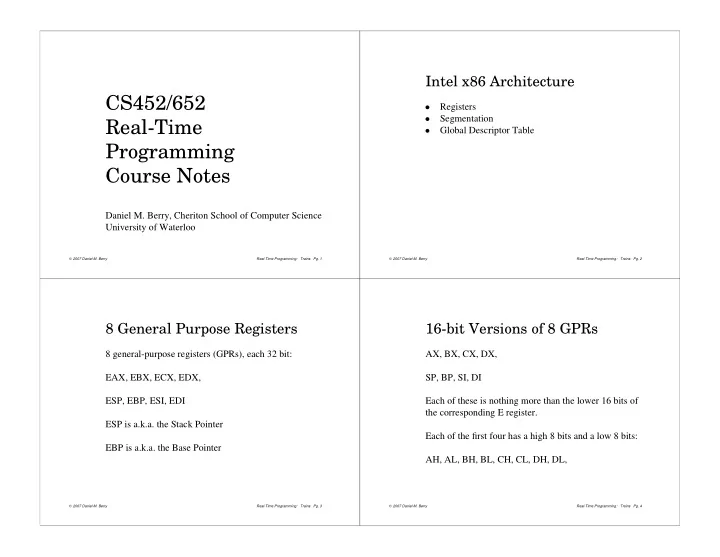

Intel x86 Architecture CS452/652 Registers g Segmentation g Real-Time Global Descriptor Table g Programming Course Notes Daniel M. Berry, Cheriton School of Computer Science University of Waterloo 2007 Daniel M. Berry Real-Time Programming: Trains Pg. 1 2007 Daniel M. Berry Real-Time Programming: Trains Pg. 2 8 General Purpose Registers 16-bit Versions of 8 GPRs 8 general-purpose registers (GPRs), each 32 bit: AX, BX, CX, DX, EAX, EBX, ECX, EDX, SP, BP, SI, DI ESP, EBP, ESI, EDI Each of these is nothing more than the lower 16 bits of the corresponding E register. ESP is a.k.a. the Stack Pointer Each of the first four has a high 8 bits and a low 8 bits: EBP is a.k.a. the Base Pointer AH, AL, BH, BL, CH, CL, DH, DL, 2007 Daniel M. Berry Real-Time Programming: Trains Pg. 3 2007 Daniel M. Berry Real-Time Programming: Trains Pg. 4
Segmented Memory Segment Registers Each address reference is confined to one segment, i.e., CS, DS, ES, FS, GS, SS a slice of memory, and is represented as an offset from the start of a segment: each 16 bits physicalAddress = startOfSegment + memoryOffset 2007 Daniel M. Berry Real-Time Programming: Trains Pg. 5 2007 Daniel M. Berry Real-Time Programming: Trains Pg. 6 Stack Segment (SS) The Available Segments SS Stack Segment CS Code Segment DS Data Segment ES Extra Data Segment SS FS Extra Data Segment This distance GS Extra Data Segment is the value of ESP Segment ESP relative to SS 2007 Daniel M. Berry Real-Time Programming: Trains Pg. 7 2007 Daniel M. Berry Real-Time Programming: Trains Pg. 8
Available Segments, Cont’d Segment Register Contents A program may not reference addresses outside the Each segment register effectively specifies: bounds of its segments. lower bound for memory accesses, g upper bound for memory accesses, g This is memory protection. access rights, i.e., read|write|execute , g etc., g for its segment. 2007 Daniel M. Berry Real-Time Programming: Trains Pg. 9 2007 Daniel M. Berry Real-Time Programming: Trains Pg. 10 All This in 16 Bits? Global Descriptor Table How do you pack all this information in a 16 bit Each segment register is an index into a table called the segment register? Global Descriptor Table (GDT) The GDT is an array of 8-byte entries. Each entry indicates: lower bound for memory accesses, g upper bound for memory accesses, g access rights, i.e., read|write|execute , g etc., g for its segment. 2007 Daniel M. Berry Real-Time Programming: Trains Pg. 11 2007 Daniel M. Berry Real-Time Programming: Trains Pg. 12
Example Task Segments If DS = 0x28 (0d40), the memory reference: Each task, including the kernel, needs 2 entries in the GDT: Then, DS:0x34 means “Add 0x34 to the base address of GDT entry DS/8 = 40/8 = 5.” 1. CS 2. DS So, if GDT[5] has base address = 0x100, then DS:0x34 means physical address 0x134, … There is no GDT in place when the kernel boots! provided that GDT[5] has an upper bound of at least 0x34. 2007 Daniel M. Berry Real-Time Programming: Trains Pg. 13 2007 Daniel M. Berry Real-Time Programming: Trains Pg. 14 Compiler Assumptions Setting up GDT A compiler assumes that SS = DS. The location of the GDT is stored in a register called GDTR. Therefore you should set DS = ES = FS = GS = SS for each task. x86 instructions lgdt sets GDTR sgdt reads GDTR Setting up the GDT is the first thing your kernel should do. 2007 Daniel M. Berry Real-Time Programming: Trains Pg. 15 2007 Daniel M. Berry Real-Time Programming: Trains Pg. 16
EFLAGS Loading a Task: ELF Format There is another register, EFLAGS, condition codes: ELF = Executable and Linkable Format: Set up CS segment to point to code segment in ELF e.g., whether hardware interrupts are enabled, results of file. last comparison, etc. Allocate memory for task’s data segment. Copy data segment from ELF file to newly allocated memory. Set up DS to point to the newly allocated memory. Don’t forget about uninitialized data. 2007 Daniel M. Berry Real-Time Programming: Trains Pg. 17 2007 Daniel M. Berry Real-Time Programming: Trains Pg. 18 Context Switch int n Behavior Kernel int n : return exitKernel (iretl) pushes ELFAGS, CS, and EIP values into g executing task’s stack looks up n th entry in interrupt descriptor table g Context Switch (IDT) jumps to the address installed in IDT[ n ] g syscall (int n) return Task 2007 Daniel M. Berry Real-Time Programming: Trains Pg. 19 2007 Daniel M. Berry Real-Time Programming: Trains Pg. 20
iretl Behavior From Task1 to Kernel iretl : 1. Set up syscall parameters pops ELFAGS, CS, and EIP values from executing 2. int n g hhhhhhhhhhhhhhhhhhhhhhhhhhhhhhhhhhhh task’s stack 3. save task1’s state on task1’s stack: pushal saves all restores these popped values into the ELFAGS, CS, g 8 GPRs and EIP registers. 4. switch stacks to kernel’s stack 5. restore kernel state from kernel stack CS, EIP come from IDT g DS — whatever you used for the kernel in GDT g ESP — save as a global variable. g hhhhhhhhhhhhhhhhhhhhhhhhhhhhhhhhhhhh 6. return from exitKernel 2007 Daniel M. Berry Real-Time Programming: Trains Pg. 21 2007 Daniel M. Berry Real-Time Programming: Trains Pg. 22 From Kernel to Task2 First Time 1. save kernel’s state on kernel’s stack The first time a task is loaded, put values on its stack so 2. switch stack to task2’s stack that on exitKernel , they will be popped like for any 3. restore task2’s state from task2’s stack: popal previously existing task. restores all 8 GPRs 4. set up return value of int n Another example of faking it! 5. iretl hhhhhhhhhhhhhhhhhhhhhhhhhhhhhhhhhhhh 6. return from syscall 2007 Daniel M. Berry Real-Time Programming: Trains Pg. 23 2007 Daniel M. Berry Real-Time Programming: Trains Pg. 24
Recommend
More recommend